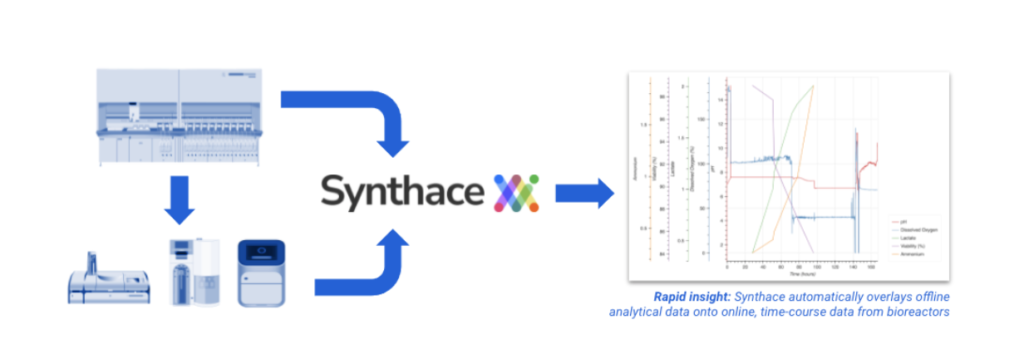Developing biological products in a fast and iterative manner means one thing: automation. Hardware companies produce various automation equipment that accelerates different parts of the pipeline, from automated experimental design to experimental execution, from data structuring to data analysis. Every pharmaceutical and biotech company is quickly adopting automation and embracing new technologies.
The fast adoption and implementation of automation are driven by three major factors:
- The requirement to ensure experimental results are repeatable, reproducible, and robust;
- Scalability for high throughput and reduced time to go to market;
- Need to free scientists from laborious execution and enable them to focus more on the science, so that they can innovate more.
However, scientists traditionally come from a non-coding background and native automation software often require a good level of coding skills. To use this software, scientists need to translate their experiments into automation scripts and think like an automation device.
It falls upon the scientists in research and development (R&D) and other stakeholders such as automation engineers, to choose hardware and software that actually achieve the goals of automation; but often the code-extensive software creates a huge barrier to adoption due to the steep learning curve of the scripting language, and over time scientists retreat back to manual experiments.

The right software interface should speak biological language that reflects the actions they might do in the lab manually such as normalize, dilute, or aliquot, rather than defining every single movement the robots need to perform. It should also scale as the team grows and more hardware automation equipment, potentially from different vendors, are adopted across multiple departments. Truly intuitive software should be an end-to-end platform that enables scientists to build their own experiments as simple as building lego.
[What does biological language look like in a software? Check out our recent demo here]
Ease Your Scripting Burden with A No-Code Cloud Platform
R&D teams have developed divergent ways to solve the issues of difficult automation scripting - some developed in-house solutions tailored to a specific user case or a group, some purchased more support from the hardware vendors; and most commonly, they formed a dedicated automation team to work on group or organization-level automation initiatives.
These ‘point solutions’ make sense as they alleviate the burden of operating and troubleshooting for scientists and help them focus on producing scientific results. However, they reduce the communication efficiency because they create silos between scientists and software providers / automation teams.
No-code and device-agnostic platforms like Synthace square this circle by being able to integrate nicely with commonly used automation hardware. Whatever scripting language the hardware speaks, scientists are able to intuitively build their experiments without prior coding knowledge and share their design/results seamlessly across multiple departments.
Meanwhile, from a long-term perspective - understanding what is your company’s goal of automation is just as important as searching for a solution to improve the experience of automation, as pharmaceutical and biotechnology companies are starting to build a sustainable digital future where teams can easily collaborate and share insights.
[How to build a sustainable digital R&D? Check out our 5-step R&D Digitalization eBook]
Another benefit of device-agnostic platforms is that if your company needs to automate specific parts of their R&D process (ie. liquid handling) and purchase a new piece of automation hardware, you know your platform will still integrate and achieve similar desired results.
Take Your Automation Further with Integrated Data
Picture this scenario in your mind: every piece of hardware is integrated into one platform, where scientists can design their experiments easily and all data output from multiple sources is organized in a single platform for further analysis. Insights are rapidly generated and decisions are made, kicking off the next iteration within a week.
Data is an asset. But the reality is that it is useless if not structured and utilized in a contextualized way.
Native automation softwares give you the ability to pump out experiment data directly into their system and they also provide analytical visualization. This might seem like a quick way to save time instead of choosing a cloud platform and storing data from multiple sources there, but it robs you of the ability to contextualize your data and build a foundation for metadata moving forward.
It’s important to find a platform where you can centralize and structure your data to power downstream analytics, perform complex processes on it, and use those results to inform decisions and the future of your R&D.

Accelerate Speed to Market
Speed to market is key. Whichever drug or biological product your company is developing, the management team is looking for solutions to streamline the process and reduce time. At a certain point, you’re going to need a no-code platform to enable your scientists to better use their time — an intuitive interface that speaks biology with a device-agnostic nature that connects all the data into a central place.
If you’re still looking for options to reduce the hardware scripting burden, don’t sink time building your in-house solutions or investing resources into native automation software. A modern no-code cloud platform is ready to equip you for your company’s next evolution with automation that could change the way you are used to working.
If you would like to see how no-code automation software can help you do more complex experiments easier and faster, book a demo or email us at hello@synthace.com.

